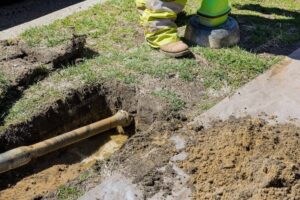Self-healing pipe materials can autonomously repair minor damages within pipes, potentially revolutionizing the way we approach pipeline maintenance and longevity.
Over time, pipes endure wear and tear from various factors such as corrosion, abrasion, and chemical exposure. These factors contribute to the gradual degradation of pipes, leading to leaks, structural weaknesses, and an overall reduction in their operational lifespan.
The conventional approach to addressing these issues involves regular inspections and, when necessary, the cumbersome process of excavation and repair. Trenchless pipe lining technologies have already made significant strides in minimizing the disruption caused by traditional repair methods. However, self-healing pipe materials take this innovation a step further, aiming to address minor damages autonomously and preemptively, before they escalate into larger, more costly problems.
Table of Contents
- What are Self-Healing Pipe Materials?
- 1.1 Microscopic Capsules and Reactive Agents
- 1.2 Polymer Networks and Shape Memory Alloys
- 1.3 Bacteria-Mediated Healing
- The Advantages of Self-Healing Pipe Materials
- 2.1 Autonomous Repair: Minimizing External Interventions
- 2.2 Extended Lifespan: Prolonging Pipeline Integrity
- 2.3 Cost-Efficiency: Reducing Maintenance Expenditure
- 2.4 Minimized Disruptions: Enhancing Operational Continuity
- Current Developments and Applications
- 3.1 Polymeric Solutions with Microencapsulation
- 3.2 Application in Water and Gas Pipelines
- 3.3 Integration in Critical Infrastructure
- Challenges and Future Prospects
- 4.1 Effectiveness Across Various Conditions
- 4.2 Long-Term Durability and Stability
- 4.3 Integration with Existing Infrastructure
- 4.4 Scalability and Cost Considerations
- Ethical and Environmental Implications
- 5.1 Environmental Impact of Material Production
- 5.2 End-of-Life Considerations
- Conclusion
What are Self-Healing Pipe Materials?
The fundamental premise behind self-healing pipe materials lies in mimicking the regenerative capabilities found in living organisms. Inspired by natural processes, these materials incorporate innovative technologies that enable them to detect, react to, and repair minor damages without external intervention.
- Microscopic Capsules and Reactive Agents
At the heart of self-healing pipe materials are microscopic capsules embedded within the material. These capsules contain reactive agents that remain dormant until the material is compromised. When a minor breach occurs, the capsules rupture, releasing the reactive agents into the damaged area. These agents then react with other components in the material, forming a resilient seal that effectively heals the breach.
- Polymer Networks and Shape Memory Alloys
Another approach involves the integration of polymer networks and shape memory alloys. Polymer networks within the material can reform and close small cracks when activated by external stimuli such as heat or pressure. Shape memory alloys add an extra layer of resilience by returning to their original form after deformation, aiding in the restoration of structural integrity.
- Bacteria-Mediated Healing
A more cutting-edge avenue explores the use of bacteria-mediated healing. Engineered bacteria embedded in the pipe material remain dormant until exposed to the specific conditions created by a breach. Once activated, these bacteria produce substances that solidify into a sealant, effectively repairing the damage.
The Advantages of Self-Healing Pipe Materials
The integration of self-healing capabilities into pipe materials presents a myriad of advantages that can reshape the landscape of pipeline maintenance and longevity.
- Autonomous Repair: Minimizing External Interventions
The primary benefit is the ability of these materials to autonomously repair minor damages. By addressing issues at their inception, self-healing pipe materials have the potential to reduce the need for frequent external interventions. It lowers maintenance costs and minimizes the disruptions caused by traditional pipe repair methods, leading to increased operational efficiency.
- Extended Lifespan: Prolonging Pipeline Integrity
The autonomous repair of minor damages contributes to the overall longevity of pipelines. Self-healing capabilities prevent small issues from escalating into more significant problems, thereby extending the lifespan of the pipes. This enhances the sustainability of infrastructure and reduces the environmental impact associated with frequent replacements and repairs.
- Cost-Efficiency: Reducing Maintenance Expenditure
While the initial investment in self-healing pipe materials may be higher, the long-term cost-efficiency is a compelling factor. The reduction in the frequency of external interventions and the extended lifespan of pipelines result in substantial cost savings over the operational life of the infrastructure.
- Minimized Disruptions: Enhancing Operational Continuity
Traditional repair methods often entail excavation, disrupting the surrounding environment and causing inconveniences. Self-healing pipe materials significantly minimize such disruptions, allowing for continuous operations without the need for extensive construction activities. This is particularly advantageous in urban areas where minimizing disruptions is a critical consideration.
Current Developments and Applications
The development of self-healing pipe materials is a dynamic field, with ongoing research and experimentation pushing the boundaries of what’s possible. Several notable developments and applications showcase the promising potential of this innovative technology.
- Polymeric Solutions with Microencapsulation
Researchers have been exploring polymeric solutions with microencapsulation as a means of creating self-healing pipe materials. These materials have demonstrated the ability to autonomously repair damages caused by mechanical stresses, offering a viable solution for pipelines exposed to external pressures.
- Application in Water and Gas Pipelines
The application of self-healing pipe materials extends beyond traditional water pipelines. Gas pipelines, which face their unique set of challenges, have also been considered for the implementation of this technology. The ability to prevent gas leaks through autonomous healing adds an extra layer of safety and reliability to gas distribution networks.
- Integration in Critical Infrastructure
The use of self-healing pipe materials is gaining traction in critical infrastructure such as nuclear power plants and industrial facilities. Ensuring the integrity of pipelines in these environments is paramount, and the self-healing capabilities offer an additional layer of protection against potential leaks or structural degradation.
Challenges and Future Prospects
While the potential of self-healing pipe materials is vast, several challenges and considerations warrant attention.
- Effectiveness Across Various Conditions
The effectiveness of self-healing capabilities may vary under different environmental conditions. Factors such as temperature fluctuations, chemical exposure, and varying pressures need to be thoroughly assessed to ensure consistent performance across diverse settings.
- Long-Term Durability and Stability
Ensuring the long-term durability and stability of self-healing pipe materials remains a focal point for ongoing research. Understanding how these materials withstand years of exposure to external factors and assessing their overall stability over extended periods is essential for widespread adoption.
- Integration with Existing Infrastructure
The seamless integration of self-healing pipe materials with existing infrastructure poses both logistical and technical challenges. Retrofitting existing pipelines with these innovative materials requires careful planning to ensure compatibility and optimal performance.
- Scalability and Cost Considerations
The scalability of self-healing pipe materials for widespread implementation in extensive pipeline networks is a consideration that demands attention. Additionally, addressing the initial costs associated with the integration of this technology remains crucial for its broader adoption across various industries.

Ethical and Environmental Implications
As with any technological advancement, it’s imperative to consider the ethical and environmental implications associated with self-healing pipe materials.
- Environmental Impact of Material Production
The production of the materials used in self-healing pipes requires resources and energy. Assessing the environmental impact of the manufacturing process and exploring sustainable material alternatives are vital aspects of ensuring that the overall environmental footprint is minimized.
- End-of-Life Considerations
Understanding the end-of-life considerations for self-healing pipe materials is essential. Assessing their recyclability and potential impact on waste management processes contributes to a holistic evaluation of the environmental implications associated with their use.
Conclusion
The development of self-healing pipe materials marks a significant leap forward in trenchless pipe repair. These materials, with their autonomous repair capabilities, have the potential to reshape the landscape of pipeline maintenance, longevity, and sustainability. Contact us to be at the forefront of this groundbreaking evolution in trenchless pipe lining technology!




